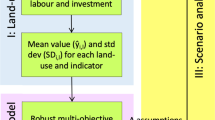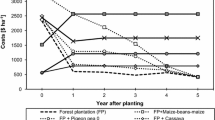Abstract
In the Philippines, smallholder farmers have become major timber producers. But the systems of timber production practiced have several limitations. In intercropping systems, the practice of severe branch and/or root pruning reduces tree-crop competition and increases annual crop yields, but is detrimental to tree growth and incompatible with commercial timber production. In even-aged woodlots, lack of regular income and poor tree growth, resulting from farmers’ reluctance to thin their plantations, are major constraints to adoption and profitable tree farming. In the municipality of Claveria, Misamis Oriental, the recent practice of planting trees on widely spaced (6–8 m) contour grass strips established for soil conservation suggests ways to improve the adoptability (i.e., profitability, feasibility and acceptability) of timber-based agroforestry systems. Assuming that financial benefits are the main objective of timber tree farmers, we develop a simple linear programming (LP) model for the optimal allocation of land to monocropping and tree intercropping that maximizes the net present value of an infinite number of rotations and satisfies farmers’ resource constraints and regular income requirements. The application of the LP model to an average farmer in Claveria showed that cumulative additions of widely spaced tree hedgerows provides higher returns to land, and reduce the risk of agroforestry adoption by spreading over the years labour and capital investment costs and the economic benefits accruing to farmers from trees. Therefore, incremental planting of widely spaced tree hedgerows can make farm forestry more adoptable and thus benefit a larger number of resource-constrained farmers in their evolution towards more diverse and productive agroforestry systems.
Similar content being viewed by others
References
InstitutionalAuthorNameADB (1994) Forestry Sector Study of the Philippines Asian Development Bank Manila, The Philippines
A. Agpaoa D. Endangan S. Festin J. Gumayagay T.H. Hoenninger G. Seeber K. Unkel H.J. Weidelt (1976) Manual of Reforestation and Erosion Control for the Philippines German Agency for Technical Cooperation, LTD. (GTZ). Eschborn
Bertomeu M. 2004. Smallholder Timber Production on Sloping Lands in the Philippines: A Systems Approach. PhD dissertation. Escuela Técnica Superior de Ingenieros de Montes, Universidad Politécnica de Madrid (UPM).
D.R. Betters (1988) ArticleTitlePlanning optimal economic strategies for agroforestry systems Agrofor. Syst. 7 17–31 Occurrence Handle10.1007/BF01890467
J.G. Borges H.M. Hoganson D.W. Rose (1999) ArticleTitleCombining a decomposition strategy with dynamic programming to solve spatially constrained forest management scheduling problems For. Sci. 45 IssueID2 201–212
S. Brumelle D. Granot M. Halme I. Vertinsky (1998) ArticleTitleA tabu search algorithm for finding good forest harvest schedules satisfying green-up constraints Eur. J. Operat. Res. 106 408–424 Occurrence Handle10.1016/S0377-2217(97)00282-8
D. Current E. Lutz S. Scherr (1995) Costs, benefits, and farmer adoption of agroforestry D. Current E. Lutz S. Scherr (Eds) Costs, Benefits, and Farmer Adoption of Agroforestry: Project Experience in Central America and the Caribbean. World Bank Environment Paper No. 14 World Bank Washington D.C., USA 1–27
L.S. Davis K.N. Johnson (1987) Forest Management. 3rd ed McGraw-Hill, Inc. New York 790
InstitutionalAuthorNameDENR-ERDB. (1998) Development and Management of Forest Plantations: A Guidebook Ecosystems Research and Development Bureau (ERDB). College Laguna, Philippines
InstitutionalAuthorNameDTI and PKII Engineers. (1996) General Land Use Plan Municipality of Claveria. Department of Trade and Industry (DTI)-Region 10 Cagayan de Oro, Philippines
Elevitch C.R. and Wilkinson K.M. 2000. Introduction to Integrating Trees into Pacific Island Farm Systems. Permanent Agriculture Resources, Holualoa, Hawaii, USA. Web site: http://www.agroforestry.net.
S. Franzel S.J. Scherr R. Coe P.J.M. Cooper F. Place (2002) Methods for assessing agroforestry adoption potential S. Franzel S.J. Scherr (Eds) Trees on the Farm: Assessing the Adoption Potential of Agroforestry Practices in Africa CAB International Nairobi, Kenya 11–35
M.M. Gacoscosim (1995) Philippine Forestry in Action Phoenix Publishing House Inc Quezon City, Philippines
D.P. Garrity P.C. Agustin (1995) ArticleTitleHistorical land use evolution in a tropical acid upland agroecosystem Agric. Ecosyst. Environ. 53 83–95 Occurrence Handle10.1016/0167-8809(94)00552-P
Garrity D.P. and Mercado A.R. 1994. Reforestation through Agroforestry: Market-driven Small-holder Timber Production on the Frontier. In: Marketing of Multipurpose Tree Products in Asia. Proceedings of An International Workshop held in Baguio City, Philippines. December 6–9, 1993. Winrock International, Bangkok, Thailand, pp. 265–268
Gonzal D.R. 1994. Gmelina Arborea-annual Crop Interactions in Contour Hedgerow Systems for Smallholder Farm Forestry. PhD dissertation, University of the Philippines at Los Baños.
InstitutionalAuthorNameITTO (1996) Annual Review and Assessment of the World Tropical Timber Situation 1996 International Tropical Timber Organization Yokohama, Japan
Z.F. Kenmore J.C. Flinn (1987) An Ethnohistory of An Upland Area: ClaveriaMisamis Oriental International Rice Research Institute (IRRI) Los Baños, Philippines
Magbanua R.D. and Garrity D.P. 1988. Acid Upland Agroecosystems: A Microlevel Analysis of the Claveria Research Site. In: Proceedings of the 1988 Acid Upland Research Design Workshop. International Rice Research Institute (IRRI), Los Baños, Philippines, pp. 1–20
Magcale-Macandog D.B., Rocamora P.M. and Predo C.D. 1999. Gmelina as improved fallow. In: Menz K., Magcale- Macandog D.B. and Rusastra I.W. (eds), Improving Smallholder Farming Systems in Imperata Areas of Southeast Asia: Alternatives to Shifting Cultivation. ACIAR Monograph No.52, pp. 121–132.
G.A. Mendoza G.E. Campbell G.L. Rolfe (1986) ArticleTitleMultiple objective programming: an approach to planning and evaluation of agroforestry systems. Part 1: Model description and development Agric. Syst. 22 243–253 Occurrence Handle10.1016/0308-521X(86)90128-9
Miah M.D.G. 1993. Performance of Selected Multipurpose Tree Species and Field Crops Grown in Association as Affected by Tree Branch Pruning. PhD dissertation, Central Luzon State University, Muñoz, Nueva Ecija, Philippines.
Nelson R.A., Cramb R.A. and Mamicpic M.A. 1996. Costs and Returns of Hedgerow Intercropping and Open-field Maize Farming in the Philippine Uplands Working Paper No. 11. University of QueenslandAustralia and SEAMEO Regional Center for Graduate Study and Research in Agriculture.
Pancel L. 1993. Forestation. Chapter 11. Tropical Forestry Handbook. Springer-Verlag. Berlin, Germany, pp. 645–725.
P.N. Pasicolan H.A.U. deHaes P.E. Sajise (1997) ArticleTitleFarm forestry: an alternative to government-driven reforestation in the Philippines For. Ecol. Manage. 99 261–274 Occurrence Handle10.1016/S0378-1127(97)00212-0
Predo C.D. 2003. What Motivates Farmers? Tree Growing and Land Use Decisions in the Grasslands of ClaveriaPhilippines. Research report No 2003-RR7. Economy and Environment Program for Southeast Asia (EEPSEA) and the International Development Research Centrepp. 56. Available at: http://web.idrc.ca/en/ev-51044-201-1-DO_TOPIC.html.
Raintree J.B. and Turray F. 1980. Linear Programming of An Experimental Leucaena-rice Alley Cropping System. IITA Research Brief 1(4).
C. Romero (1994) Economía de los recursos ambientales y naturales Alianza Economía Madrid, España
J.M. Roshetko Mulawarman P. Purnomosidhi (2004) ArticleTitleGmelina arborea – a viable species for smallholder tree farming in Indonesia? New For. 28 207–215
Santiago R.G. 1997. Livelihood Enhancement Thru Agroforestry (LEAF) Program. In: Developments in Agroforestry Research. ICRAF, FAO-APANPCARRD and DOST, Los Baños, Laguna, Philippines, Book Series No. 160/97, pp. 45–56
G.E Shively (1998) ArticleTitleImpact of contour hedgerows on upland maize yields in the Philippines Agrofor. Syst. 39 IssueID1 59–71 Occurrence Handle10.1023/A:1005964908403
S. Snyder C. ReVelle (1996) ArticleTitleTemporal and spatial harvesting of irregular systems of parcels Can. J. For. Res. 26 1079–1088
M. Stark (2000) Soil Management Strategies to Sustain Continuous Crop Production between Vegetative Contour Strips on Humid Tropical Hillsides. Technology Development and Dissemination based on Farmers’ Adaptive Field Experimentation in the Philippines International Center for Research in Agroforestry, Southeast Asia Regional Research Programme Bogor, Indonesia
R.B. Valdez (1991) New Techniques On Site Preparation and Outplanting. In: Improved Reforestation Technologies in the Philippines Book Series No. 121 PCARRD Los Baños, Laguna, Philippines 79–83
I. Verinumbe H.C. Knipscheer E.E. Enabor (1984) ArticleTitleThe economic potential of leguminous tree crops in zero-tillage cropping in Nigeria: a linear programming model Agrofor. Syst. 2 IssueID2 129–138
H. Watanabe (1992) Tree-crop interactions in Taungya plantations C.F. Jordan J. Gajaseni H. Watanabe (Eds) Taungya: Forest Plantations with Agriculture in Southeast Asia CAB International Wallingford, UK 32–43
Author information
Authors and Affiliations
Corresponding author
Rights and permissions
About this article
Cite this article
Bertomeu, M., Bertomeu, M. & Giménez, J.C. Improving adoptability of farm forestry in the Philippine uplands: a linear programming model. Agroforest Syst 68, 81–91 (2006). https://doi.org/10.1007/s10457-006-0005-7
Received:
Accepted:
Issue Date:
DOI: https://doi.org/10.1007/s10457-006-0005-7




